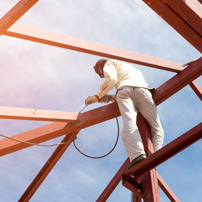 Construction is a hazardous industry. One in five worker fatalities happen in construction. There are four types of accidents responsible for more than 60 percent of construction worker deaths. These are the so-called Fatal Four: falls, struck-by object, electrocution, and caught-in/between accidents.
Construction is a hazardous industry. One in five worker fatalities happen in construction. There are four types of accidents responsible for more than 60 percent of construction worker deaths. These are the so-called Fatal Four: falls, struck-by object, electrocution, and caught-in/between accidents.
According to the Occupational Safety and Health Administration (OSHA), eliminating the Fatal Four could save 631 workers’ lives annually in the U.S. Fortunately, there are many steps that can be taken to prevent Fatal Four accidents from happening on construction sites. The following guidelines include safety recommendations from OSHA.
Falls
Falls are the number one cause of fatalities in construction work. Even when a fall does not result in a fatality, it can cause serious injuries including head and neck injuries, and spinal cord injuries. This is why fall protection is required for workers at heights of six feet and above.
Guardrails and toe-boards should be installed on every elevated open platform or scaffolding. Safety net systems and personal fall and arrest systems are also accepted methods of fall protection. Workers should be well trained in how to use their personal protective equipment.
Struck by Object Accidents
Struck-by object accidents accounted for more than nine percent of deaths in construction in 2016. This category includes workers struck by suspended loads that come loose, falling tools or materials left unsecured, flying debris from power tools, and contact with moving heavy machinery.
To prevent this type of accident, tools and materials must always be secured. Toe-boards, screens, and debris nets help keep objects from reaching workers who should be wearing hard hats at all times. Those using power tools should be provided with goggles, a face shield, or safety glasses. No worker should ever be positioned underneath a suspended load and the area where cranes and other heavy machinery are being operated must be clearly marked off.
Electrocution
Electrocutions were the third most common cause of fatalities. Electrical violations were on the top ten list of OSHA citations in 2016. The greatest risk of electrocution in construction comes from contact with overhead or buried power lines. Other sources include live wires, defective power tools, and faulty extension cords.
To prevent electrocutions, OSHA has strict distance requirements for the operation of machinery near power lines. All power lines and utilities should be identified and clearly marked before any work begins. Workers on ladders and scaffolding must be aware of nearby power lines. Portable electric tools must be grounded or double insulated. Construction site managers must also comply with OSHA standards for electrical wiring methods and systems.
Caught In/Between Accidents
The last of the Fatal Four is deaths that occur when a worker is caught-in or compressed by equipment or objects, or caught-in and crushed by a collapsing structure, equipment, or materials. To prevent these accidents, machinery must have proper safety guards so that workers cannot be pulled into moving parts. Excavation work must have adequate protection such as shoring, sloping, benching, or trench shield system.
Delaware County Construction Accident Lawyers at Eckell Sparks Represent Injured Construction Workers and Their Families
If you have suffered injuries in a construction accident, you may be entitled to compensation through a third party personal injury claim. The Delaware County construction accident lawyers at Eckell, Sparks, Levy, Auerbach, Monte, Sloane, Matthews & Auslander, P.C. will fight to get you the compensation you deserve. Call 610-565-3701 to schedule a free consultation in our West Chester or Media offices. You can also contact us online. We assist clients throughout Southeastern Pennsylvania, including those in Delaware County, Chester County and the greater Philadelphia area.

